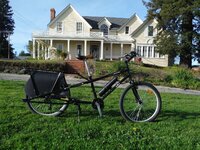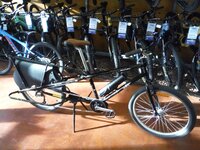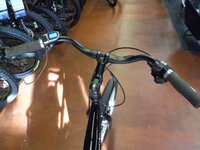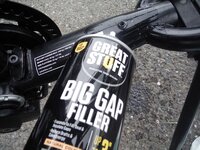Going on about the motors, are you saying that any hub motor with the power and torque to get all that cargo moving would need to be something massive like what they use on those moto cross style bikes?
Also for the frame I think steel will work plus its much easier to find someone to build it.
Then use his bike if it works so well

. If all you have to do is put a rider on it thats a different set of rules. Once that guy finishes with his chute it looks like he has little else besides his jumpsuit to carry along, and I see neither a motor or a battery. Regardless, if its a viable platform use that. Otherwise ...
Motor size: Not that big, but it could not be small. What you have to pay attention to is the Nm torque rating of the motor, and figure out how much that is going to be affected by your battery size, voltage and the controller amperage. In particular, controller amperage = torque, as in more amps = more torque. But the motor itself can only give out so much before it either gives no more or bad things happen to it.
This is where you start to run into the words 'impossible'. Hub motors are by their nature single speed. Up a steep hill they provide the same gearing as they do on flat ground or downhill. Or on pavement vs. sand up past the rims. Two hub motors will help immensely with the problem, but it is inherent in your chosen platform. So you have to overpower it to be able to do the same job a mid drive can thanks to the fact it can use gears (think of how your life would suck if you were the motor (i.e. the rider) and were riding single-speed).
Consider this: A heavy electric cargo bike is doing good carrying a rider and 100 lbs of cargo. You want to shrink the platform and have it work in conditions that are far worse than any cargo bike application. Oh and it has to be folded, worn on the body and take whatever stresses go along with a jump. If you want just an ebike, never mind the heavy cargo capacity, thats a pretty tall order as it is.
If you haven't done it yet, I suggest you get on a bicycle - a normal electric one - and ride it in singletrack or overland terrain with 100 lbs of gear. Once you realize from experience what you are up against, work from there. Just for starters: Fat tires to handle the weight. And because fat, probably 20". I learned in auto racing (working with an engineer from Hoosier talking to me thru a back channel, because lawyers) about sidewall height and tire pressures, and it carried directly forward into cargo bike hauling. Its why I graduated up to a Surly Big Fat Dummy when I was carrying 100-125 lb loads. And after the first ride I knew it was the right move. Given your constraints, plus your usage, you absolutely need 20" or smaller wheels (torque advantage) and the fattest rubber with the tallest sidewall you can muster.
FYI when the Sondors Fold XS was in development, it was originally going to get the same 25a controller the 26" fat tire XS was going to get. But thanks to the smaller wheel diameter 25a turned the bike into a wheelie machine, which is bad for ma and paw who just want to have a peppy ride around the neighborhood. So they used less power. This same torque advantage thanks to the smaller wheels is something you can take advantage of to help you move closer to your goals.






